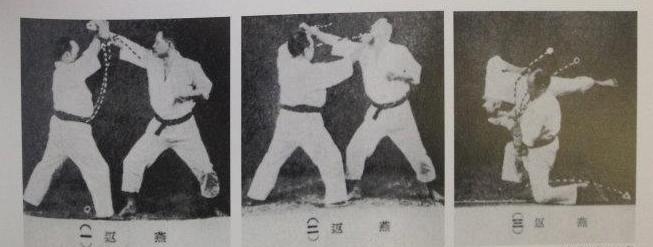(This post concerns steps 10-15 of Choong-Jang. Find a video here)
A while back I made a post about how I could not see the drop to the ground in Choong-Jang as a takedown, and that maybe it was a falling technique in case your opponent pushed you to the ground. Later on I read through Funakoshi's Nine Throws (Ginchin Funakoshi being the founder of Shotokan karate) to see if any were used in the ITF patterns. That's when I came across the "Swallow Reversal" throw.
 |
| Image originally from Funakoshi's Karate-Do Kyohan (1935) |
Does that last image look familiar? I now think this is the inspiration for the drop in Choong-Jang.
What has changed are the preceding movements. In Funakoshi's version a twin block is used to hold the opponent's arm while striking the chin. In Choong-Jang a high spearhand is used. In Woo-Nam (an early, abandoned version of Choong-Jang) a middle punch sliding forward is used. A low front kick to the knee is performed beforehand in both versions.
| High spearhand application. Source: David Rivas |
After kicking the opponent's knee, use the spearhand either to push back the opponent's neck or to slap the right side of their face. This turns the opponent away from you. Your reaction hand pulls their right arm. From here, use the drop as Funakoshi's takedown, pressing your right palm into the opponent's inner-elbow as you pull.
The rest of the set
You must commit to dropping for the throw to work, but the risk of this is that if the throw fails then you are on the ground.
The pattern (both in Choong-Jang and Woo-Nam) tells us to follow with a roundhouse kick from the ground, presumably to their groin. We then follow with a punch, placing our left palm forward. The Woo-Nam instructions specifically tell us this is to trap the opponent's instep, so the "punch" actually becomes a knee-bar, pushing the opponent to the ground.
| Source: Paul O'Leary |
From here, use the next two movements (the side elbow thrust followed by the clockwise turn into the forearm guarding block) to manipulate the opponent's leg. One way to do this is to thrust the opponent's ankle forward (left fist) while pulling their knee (right fist). You then use the clockwise turn to finish the lock if they resist. Alternatively, trap their ankle as you spin.
 |
| An example of forcing the opponent onto their stomach with a clockwise turn. It's difficult to see, but the tori semi-circles around with his left leg, keeping his right leg in place. Source: Judoinfo.com/leglocks |